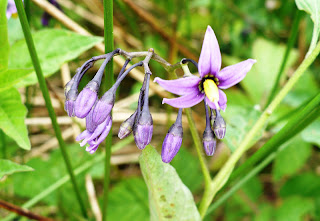Bittersweet (Solanum dulcamara) and Slender thistle (Carduus tenuiflorus) were both in bloom in Penclacwydd. There, an Ox-eye daisy (Leucanthemum vulgare) was producing rays in a strange place. The weather had also brought out the Yellow dungfly (Scatophaga stercoraria) along with a small hoverfly (Meliscaeva cinctella) and a Robberfly.
This blog may help people explore some of the 'hidden' issues involved in certain media treatments of environmental and scientific issues. Using personal digital images, it's also intended to emphasise seasonal (and other) changes in natural history of the Swansea (South Wales) area. The material should help participants in field-based modules and people generally interested in the natural world. The views are wholly those of the author.
Subscribe to:
Post Comments (Atom)
Flowers of Oahu 177. Sea hibiscus (Talipariti tiliaceum)
This is a varigated variety, known locally as Mahoe.

-
I n the UK and US, a pparently popular and successful vegan/vegetarian restaurants are reportedly closing or adding meat to their menus ( ...
-
Early ripening fruit may seem convenient but some folk think it confirms environmental stress. There's also a possibility th...






%20mating%20NWCW.jpg)


No comments:
Post a Comment